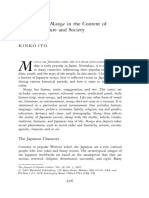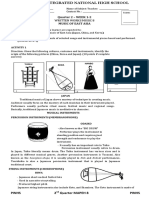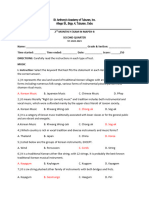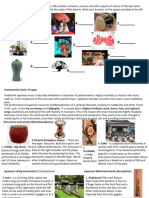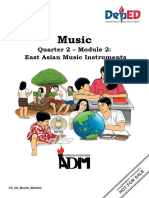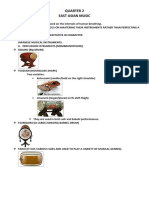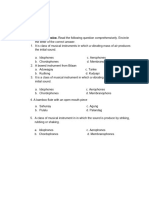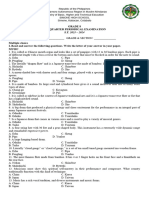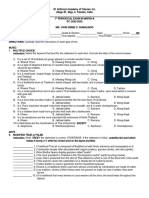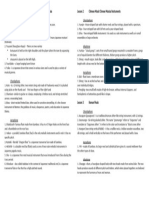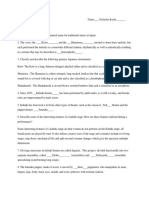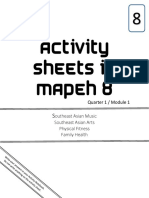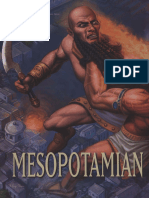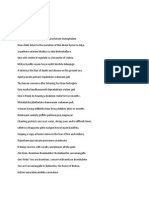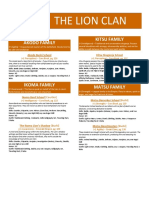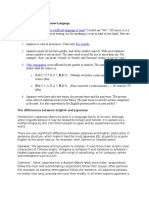0 ratings0% found this document useful (0 votes)
46 viewsUNIT TEST in MUSIC Q2
UNIT TEST in MUSIC Q2
Uploaded by
Reynaldo Collado JrThis document contains a music unit test with multiple choice and fill-in-the-blank questions about instruments from Japan, China, and Korea. The test includes a table to fill in with musical instruments matched to their country of origin and classification. It also identifies various instruments and asks students to select the correct name of the instrument being described from a word bank. The test aims to assess students' knowledge of traditional East Asian instruments and their characteristics.
Copyright:
© All Rights Reserved
Available Formats
Download as DOCX, PDF, TXT or read online from Scribd
UNIT TEST in MUSIC Q2
UNIT TEST in MUSIC Q2
Uploaded by
Reynaldo Collado Jr0 ratings0% found this document useful (0 votes)
46 views1 pageThis document contains a music unit test with multiple choice and fill-in-the-blank questions about instruments from Japan, China, and Korea. The test includes a table to fill in with musical instruments matched to their country of origin and classification. It also identifies various instruments and asks students to select the correct name of the instrument being described from a word bank. The test aims to assess students' knowledge of traditional East Asian instruments and their characteristics.
Original Title
UNIT TEST in MUSIC Q2.docx
Copyright
© © All Rights Reserved
Available Formats
DOCX, PDF, TXT or read online from Scribd
Share this document
Did you find this document useful?
Is this content inappropriate?
This document contains a music unit test with multiple choice and fill-in-the-blank questions about instruments from Japan, China, and Korea. The test includes a table to fill in with musical instruments matched to their country of origin and classification. It also identifies various instruments and asks students to select the correct name of the instrument being described from a word bank. The test aims to assess students' knowledge of traditional East Asian instruments and their characteristics.
Copyright:
© All Rights Reserved
Available Formats
Download as DOCX, PDF, TXT or read online from Scribd
Download as docx, pdf, or txt
0 ratings0% found this document useful (0 votes)
46 views1 pageUNIT TEST in MUSIC Q2
UNIT TEST in MUSIC Q2
Uploaded by
Reynaldo Collado JrThis document contains a music unit test with multiple choice and fill-in-the-blank questions about instruments from Japan, China, and Korea. The test includes a table to fill in with musical instruments matched to their country of origin and classification. It also identifies various instruments and asks students to select the correct name of the instrument being described from a word bank. The test aims to assess students' knowledge of traditional East Asian instruments and their characteristics.
Copyright:
© All Rights Reserved
Available Formats
Download as DOCX, PDF, TXT or read online from Scribd
Download as docx, pdf, or txt
You are on page 1of 1
UNIT TEST in MUSIC (Quarter 2) III. COMPLETION. Complete the following table.
Name:_______________________ Date:____ Instrument Country Classification
(Japan, (Membranophone,
I. TRUE or FALSE. Directions. Write R if the statement China, or Aerophone, or
is correct and J if the statement is wrong. Korea) Chordophone)
___1. Japan’s music is characterized by slow and
meditative melody.
Example:
___2. Koto is a zither with 12 strings. Japan Chordophone
Koto
___3. A shamisen is a membranophone. 1. Shamisen
___4. Kotsuzumi is an hourglass-shaped drum that is
placed on the left thigh. 2. Zheng
___5. Erhu is from China. 3. Changgo
___6. China’s “mouth organ” is called sho.
4. Shinobue
___7. The physical energy of the odaiko performer is an
integral part of Japanese festivals. 5. Geomungo
___8. The Korean wind instrument made of bamboo is 6. Piri
called a Changgo.
___9. Kayagum is a zither-like instrument with 6 strings. 7. Tsuridaiko
___10.The two small bells made of high-tin in China is 8. Dizi
referred as pengling.
9. Ryuteki
II. IDENTIFICATION. Determine what is being asked 10. Yunluo
in the following statements. Choose your answer from
the box.
1. A moon-shaped lute with a shorter neck and four
strings from China is called ________.
2. This is a Japanese free reed similar to China’s Sheng.
3. This literally means “cloud of gongs”.
4. An ancient Chinese instrument that has an arched
surface and elongated-trapezoid with 13 to 21 strings
stretched over individual bridges.
5. This literally means “dragon flute”.
“And heaven warns, thou shall not cheat.”
6. The most famous flute made of bamboo from Japan is
the ________.
7. A 13-stringed zither made of Paulownia wood.
-End of Test-
8. A large hanging barrel drum
9. Four-stringed lute with 30 frets.
10. Traditional Chinese flute
11. A 2-stringed fiddle from Korea
12. Korea’s hourglass-shaped membranophone is
referred as _________.
13. Literally referring as “correct music”; a music
written by upper-class literati of Joseon society.
14. Japan’s big drum is called ______.
15. Korean music for lower classes.
Ryuteki Chong-ak Dizi
Yunluo Koto Sho
Shakuhachi Changgo Tsuridaiko
Shinobue Pengling Pipa
Yueqin Sog-ak Haegum
Zheng Odaiko Taiko
You might also like
- Japanese Stories for Language Learners: Bilingual Stories in Japanese and English (Online Audio Included)From EverandJapanese Stories for Language Learners: Bilingual Stories in Japanese and English (Online Audio Included)Rating: 3.5 out of 5 stars3.5/5 (9)
- Memento FranceDocument56 pagesMemento FranceDiana CasyNo ratings yet
- Budoya Catalogue BooksDocument20 pagesBudoya Catalogue BooksΛευτέρης Ελευθεριάδης100% (1)
- Best of Dave Lowry PDFDocument188 pagesBest of Dave Lowry PDFittsukan100% (4)
- A History of Manga in The Context Ofjapanese Culture and Society PDFDocument20 pagesA History of Manga in The Context Ofjapanese Culture and Society PDFHelena Couto100% (1)
- Summative Test q2Document3 pagesSummative Test q2Rijah VenzonNo ratings yet
- Music and Arts8 WWPT 2nd QuarterDocument10 pagesMusic and Arts8 WWPT 2nd Quarterivy macalaladNo ratings yet
- Unit Test in Music of East AsiaDocument2 pagesUnit Test in Music of East AsiaDor Lenn100% (1)
- Activity 2.1 in MusicDocument3 pagesActivity 2.1 in MusicEllord JohnNo ratings yet
- Mapeh 8 Q2 Quiz Music InstrumentsDocument1 pageMapeh 8 Q2 Quiz Music InstrumentsPangs Machado VergaraNo ratings yet
- Music: Quarter 1 - Module 2Document22 pagesMusic: Quarter 1 - Module 2Ddeow grtilNo ratings yet
- 2nd Quarter LASDocument5 pages2nd Quarter LASRonalyn Cuesta NaongNo ratings yet
- 2nd Monthly Exam - MAPEH 8Document3 pages2nd Monthly Exam - MAPEH 8Jasper MomoNo ratings yet
- Second Quarter Examination in Music 8Document2 pagesSecond Quarter Examination in Music 8Dante G. Jamin67% (3)
- Music Q1 JapanDocument4 pagesMusic Q1 Japanpatriciomaryrose557No ratings yet
- Mapeh 8 Quiz 2nd QuarterDocument1 pageMapeh 8 Quiz 2nd QuarterMet Xii100% (6)
- Music Q2-Module 2Document27 pagesMusic Q2-Module 2mecahjoy.singularNo ratings yet
- Western Mindanao Adventist Academy: Music 8Document1 pageWestern Mindanao Adventist Academy: Music 8Aimelenne Jay AninionNo ratings yet
- East Asian MusicDocument7 pagesEast Asian MusicMi ChieNo ratings yet
- Mapeh 8 Summative TestDocument3 pagesMapeh 8 Summative TestMa.Agnes Kristin Sermonia100% (2)
- Mapeh 7 ExamDocument5 pagesMapeh 7 Examdarylserrano07No ratings yet
- Unit Test in Music and Arts (Quarter 2)Document3 pagesUnit Test in Music and Arts (Quarter 2)mtgleaggabaoNo ratings yet
- Unit Test in Music and Arts (Quarter 2)Document3 pagesUnit Test in Music and Arts (Quarter 2)mtgleaggabaoNo ratings yet
- 4th Quarter Test in MAPEH 8-1Document2 pages4th Quarter Test in MAPEH 8-1Nympha MorillaNo ratings yet
- Compilation of Assessment MAPEH8 q2Document20 pagesCompilation of Assessment MAPEH8 q2ERVIN DANCANo ratings yet
- Music Arts Long TestDocument5 pagesMusic Arts Long TestMARK BUÑALESNo ratings yet
- MAPEH-FIRST-QUARTER 2nd Answer Key CounterDocument4 pagesMAPEH-FIRST-QUARTER 2nd Answer Key Counterjack macabatalNo ratings yet
- Quarter 2 LEARNING ACTIVITY SHEET IN MUSICDocument2 pagesQuarter 2 LEARNING ACTIVITY SHEET IN MUSICquinnerno86No ratings yet
- Music Activity 9Document3 pagesMusic Activity 9John CaballeroNo ratings yet
- 8 Musicartssummative 2 NdquarterDocument2 pages8 Musicartssummative 2 NdquarterChester Rey VillordonNo ratings yet
- Mapeh 6 Module 7Document16 pagesMapeh 6 Module 7Jerome QuitebesNo ratings yet
- Fourth Quarter Long Test in Music 8: II. ENUMERATION: Enumerate The FollowingDocument2 pagesFourth Quarter Long Test in Music 8: II. ENUMERATION: Enumerate The FollowingLetlet Nieves RodriguezNo ratings yet
- 2ndPT MAPEH 8 TQs FINALDocument2 pages2ndPT MAPEH 8 TQs FINALJasper MomoNo ratings yet
- Lesson Design in Mapeh 8Document5 pagesLesson Design in Mapeh 8robert.lantice1992No ratings yet
- Score:: Division of Taguig City and Pateros Diosdado Macapagal High School Unit Test Mapeh Grade 8Document5 pagesScore:: Division of Taguig City and Pateros Diosdado Macapagal High School Unit Test Mapeh Grade 8NinoNo ratings yet
- Q2 Music Long QuizDocument12 pagesQ2 Music Long QuizjeanbbensonNo ratings yet
- Second Quarterly Examination in Music 8Document2 pagesSecond Quarterly Examination in Music 8loraine mandapNo ratings yet
- 1stPT MAPEH 8 TQs FINALDocument3 pages1stPT MAPEH 8 TQs FINALJasper MomoNo ratings yet
- Long Quiz in Music 8 (2nd Q)Document1 pageLong Quiz in Music 8 (2nd Q)mtgleaggabaoNo ratings yet
- Music 8 W1 4Document9 pagesMusic 8 W1 4Joseph Vincent A SalvadorNo ratings yet
- Music 2nd QTRDocument1 pageMusic 2nd QTRBhai RoggNo ratings yet
- MAPEH 2nd QUARTERY REVIEWERDocument2 pagesMAPEH 2nd QUARTERY REVIEWERkylynnctanNo ratings yet
- MAPEH-8 Q2 Mod3Document33 pagesMAPEH-8 Q2 Mod3Joshua BaluyotNo ratings yet
- Music Q2-Module 3Document20 pagesMusic Q2-Module 3mecahjoy.singularNo ratings yet
- Grade 8 2nd QuarterDocument3 pagesGrade 8 2nd QuarterAyesha MeloNo ratings yet
- Q4 Mapeh 8 A and P.T 2Document1 pageQ4 Mapeh 8 A and P.T 2Leahvanessaerika DizonNo ratings yet
- 2nd Q ExamDocument3 pages2nd Q ExamJayson GardonNo ratings yet
- Grade 8 - Summative TestDocument3 pagesGrade 8 - Summative TestRichard FranciscoNo ratings yet
- In Christ Alone SampleDocument32 pagesIn Christ Alone SampleJerome MapacpacNo ratings yet
- Mapeh-8music Q2 Summative-TestDocument3 pagesMapeh-8music Q2 Summative-TestRey Beria100% (1)
- Music: Quarter 2 - Module 2: East Asian Music InstrumentsDocument32 pagesMusic: Quarter 2 - Module 2: East Asian Music InstrumentsRonald James Condino Reil0% (1)
- 8 Final Mapeh 8 Music Q2 M2 Week 2Document17 pages8 Final Mapeh 8 Music Q2 M2 Week 2miracle greyNo ratings yet
- Japan Study GuideDocument3 pagesJapan Study GuideSalman KhalidNo ratings yet
- Music 8Document4 pagesMusic 8iza suarezNo ratings yet
- Music: Quarter 2 - Module 2: East Asian Music InstrumentsDocument32 pagesMusic: Quarter 2 - Module 2: East Asian Music InstrumentsAngel Eilise0% (1)
- Mapeh8 q4 w4 StudentsversionDocument15 pagesMapeh8 q4 w4 StudentsversionAlbert Ian CasugaNo ratings yet
- 2nd Quarter Music 8 SLEM Week 1Document9 pages2nd Quarter Music 8 SLEM Week 1Ghia Cressida HernandezNo ratings yet
- 2ND Quarter Exam in Mapeh 8Document6 pages2ND Quarter Exam in Mapeh 8Wilson MoralesNo ratings yet
- Summative MusicDocument5 pagesSummative MusicJames Paul Micael GargantaNo ratings yet
- Music 8 Q4 M1Document24 pagesMusic 8 Q4 M1Rianne Avendano Galvez67% (3)
- Grade 8 q1 TestDocument5 pagesGrade 8 q1 TestMarian Krista QuinonezaNo ratings yet
- Activity in MAPEH9 Q1 M1Document19 pagesActivity in MAPEH9 Q1 M1Rocky AbrenicaNo ratings yet
- Music of East Asia: Gallanosa National High SchoolDocument6 pagesMusic of East Asia: Gallanosa National High SchoolHarmel VargasNo ratings yet
- Korean in a Hurry: A Quick Approach to Spoken KoreanFrom EverandKorean in a Hurry: A Quick Approach to Spoken KoreanRating: 2 out of 5 stars2/5 (1)
- Update Roster Loader 2024 - Jan - FebruariDocument1 pageUpdate Roster Loader 2024 - Jan - FebruarisuparnoplaosanNo ratings yet
- 5105 Arcania - Gods of The WorldDocument32 pages5105 Arcania - Gods of The WorldDominic100% (1)
- Adya StotraDocument4 pagesAdya StotraSusanta Kumar DashNo ratings yet
- 2 Creation Myth Japan and ChinaDocument10 pages2 Creation Myth Japan and China29camziiNo ratings yet
- ContadoresDocument11 pagesContadoresReynaldo HurtadoNo ratings yet
- Pain For PrideDocument4 pagesPain For PrideInna RoscaNo ratings yet
- Yayoi Kusama Article PDFDocument2 pagesYayoi Kusama Article PDFapi-275221050No ratings yet
- Comparison of Karate StylesDocument3 pagesComparison of Karate Stylessamor-2No ratings yet
- Classification of The Japonic Languages - WikipediaDocument13 pagesClassification of The Japonic Languages - Wikipediayukiko10No ratings yet
- Tugas Semester 6Document19 pagesTugas Semester 6jastirempe15No ratings yet
- Move To Global War JapanDocument35 pagesMove To Global War JapanSaketh Vuppalapati100% (2)
- Tsuba, and Japanese Sword FittingsDocument48 pagesTsuba, and Japanese Sword FittingsPaolo Patelli100% (3)
- The Lion Clan: Akodo Family Kitsu FamilyDocument2 pagesThe Lion Clan: Akodo Family Kitsu FamilyMarco Aparicio SchönherrNo ratings yet
- The WallflowerDocument3 pagesThe WallflowerezealandNo ratings yet
- Characteristics of The Japanese LanguageDocument5 pagesCharacteristics of The Japanese LanguageJune CostalesNo ratings yet
- Relic Hunter Nov/Dec 2012Document64 pagesRelic Hunter Nov/Dec 2012James Fariello0% (1)
- Essentials of ShintoDocument436 pagesEssentials of Shintogavriel100% (6)
- Numbers in JapaneseDocument62 pagesNumbers in Japanesecarlieyy anneNo ratings yet
- Kamen RiderDocument9 pagesKamen RiderIruha HideyatsuNo ratings yet
- Nihongo ReviewerDocument5 pagesNihongo ReviewerLody V. SarandiNo ratings yet
- Shinobi Shad PDFDocument128 pagesShinobi Shad PDFДаниил Захаров100% (1)
- The Origins of The Ainu Language.Document15 pagesThe Origins of The Ainu Language.Yusuf GürseyNo ratings yet
- Kanji Picto GraphixDocument218 pagesKanji Picto Graphixgabrielalob100% (7)
- Ainu LanguageDocument11 pagesAinu LanguageErunerNo ratings yet
- History of Japanese LiteratureDocument17 pagesHistory of Japanese LiteratureSkux LearnerNo ratings yet
- 21st Century Literature From The Philippines To The WorldDocument11 pages21st Century Literature From The Philippines To The WorldMelmar RiveraNo ratings yet




